If you have never grown corn before, I strongly recommend it if you really enjoy the taste of corn. Juicy, sweet with some salt sprinkled on top and buttered up! That’s the way I like to eat mine. Even though it is not my main pantry stocking crop, I grow it every year. I like growing corn because nothing compares to its fragrance and flavor, and it is one of those plants that surprisingly does not attract many pests, it grows very well on its own as long as I fertilize and water it, well.
Corn is a warm-weather crop, therefore can be sowed indoors about 6 weeks before the last frost and then transplanted into the garden outdoors after the last frost. It can also be directly sowed outdoors after the danger of the last frost is over. Seedlings should be spaced about 8-12 inches apart. The best location for corn is an area with full sun, as corn needs at least 8 hours of sun, the more the better. The soil should be well-drained and fertile. If the soil needs some amending, add at least 2 inches of compost or aged animal manure or other rich organic matter and mix with the rest of the soil about 5-6 inches deep.
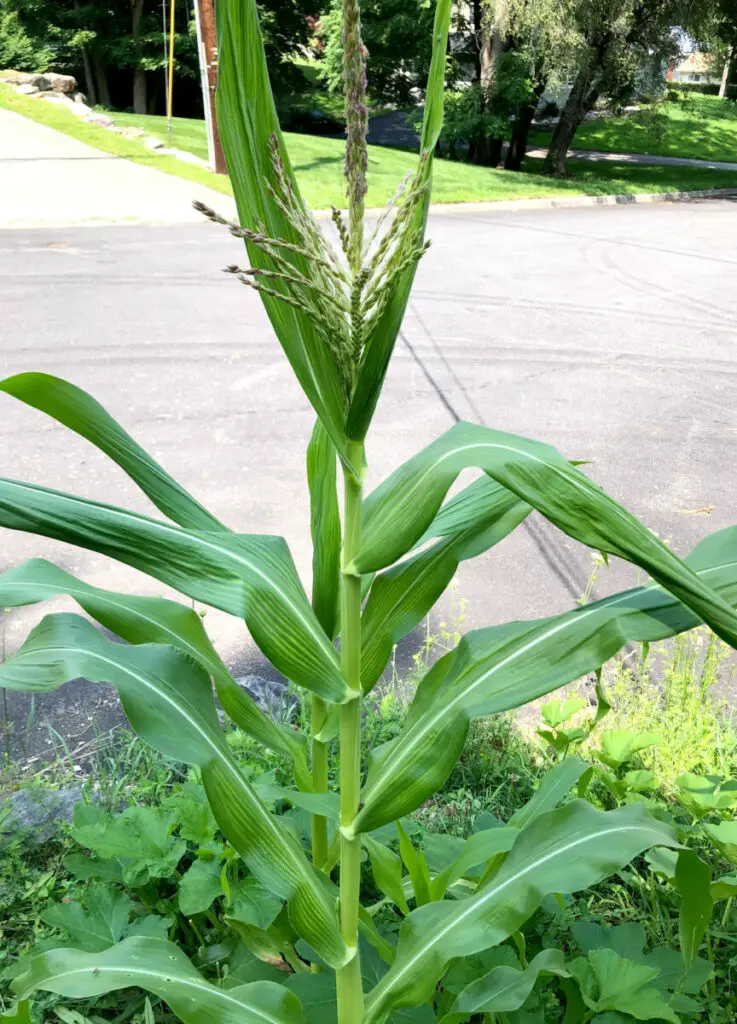
What is the best month to plant corn?
April is the best month to start corn from seed indoors. Start early in April, and about 6 weeks before the last frost date. It can be planted anywhere between late April to early May, depending on the hardiness zone and last frost date in your area. The plant usually recovers if the temperatures fall anywhere between 32F and 28F but if the temperatures persist around 28F or less for a few hours, the plant might get killed and not recover.
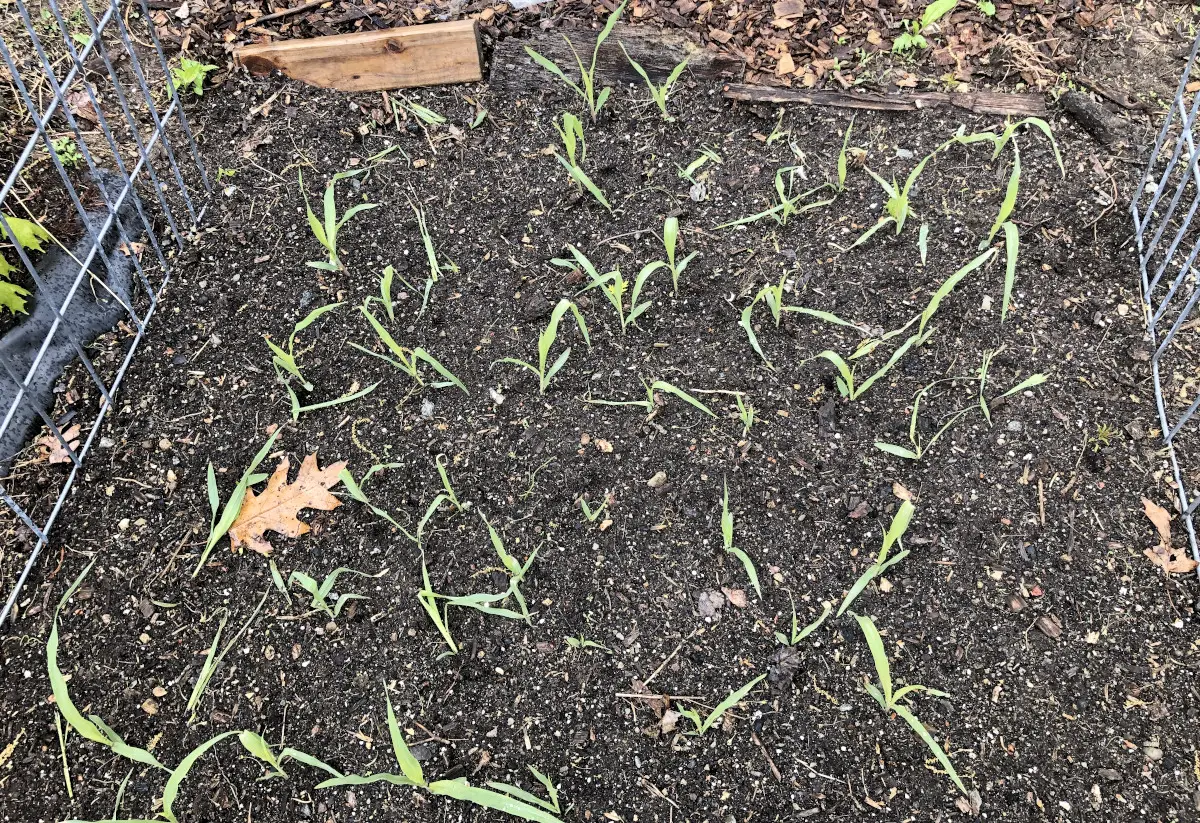
I usually start my corn indoors. I like to soak the seeds as they are hard and very dry. I soak them for about 24 hours up to 2 days. Then I plant them. This year, I did not have time to plant them after soaking so I just left them sit in the jar after I strained them. They started to sprout, so I knew the seeds were viable and would grow well. When they were about 10 inches tall, I transplanted them in the garden. I planted them in the spot where I used to trench compost all my kitchen scraps for years and then turned the spot into a garden bed to get more growing space. So, the soil where the corn was planted was very fertile, full of organic matter, and loamy.
In this article How to start a compost pile, I share my method of composting, and about trench composting which I practice every year. With a trench compost method, I simply bury kitchen scraps directly into the garden bed. Read here, to explore more about trench composting, when to do it, and how.
This year, I wish to increase the yield of my garden and to ensure that result, I now fertilize with a liquid fertilizer weekly. I got this 1-gallon concentrate which I dilute by 10 mill per gallon of water. So, it will last me for a long time. It contains 6 percent of nitrogen, 4 percent phosphorus, and 4 percent potassium. It is suitable for vegetables and flowers, a great combo since I like to use one thing a hundred different ways. And this fertilizer is just that. Because it is a concentrate, I can make it as gentle or as strong as I need, depending on whether I want to fertilize tender seedlings or mature plants. So far, my cabbages, cauliflower, head salad, and broccoli look the best yet! Yay!
Should I soak corn before planting?
Corn does not have to be soaked before planting, but it is recommended as soaking the corn seeds will help speed the germination process.
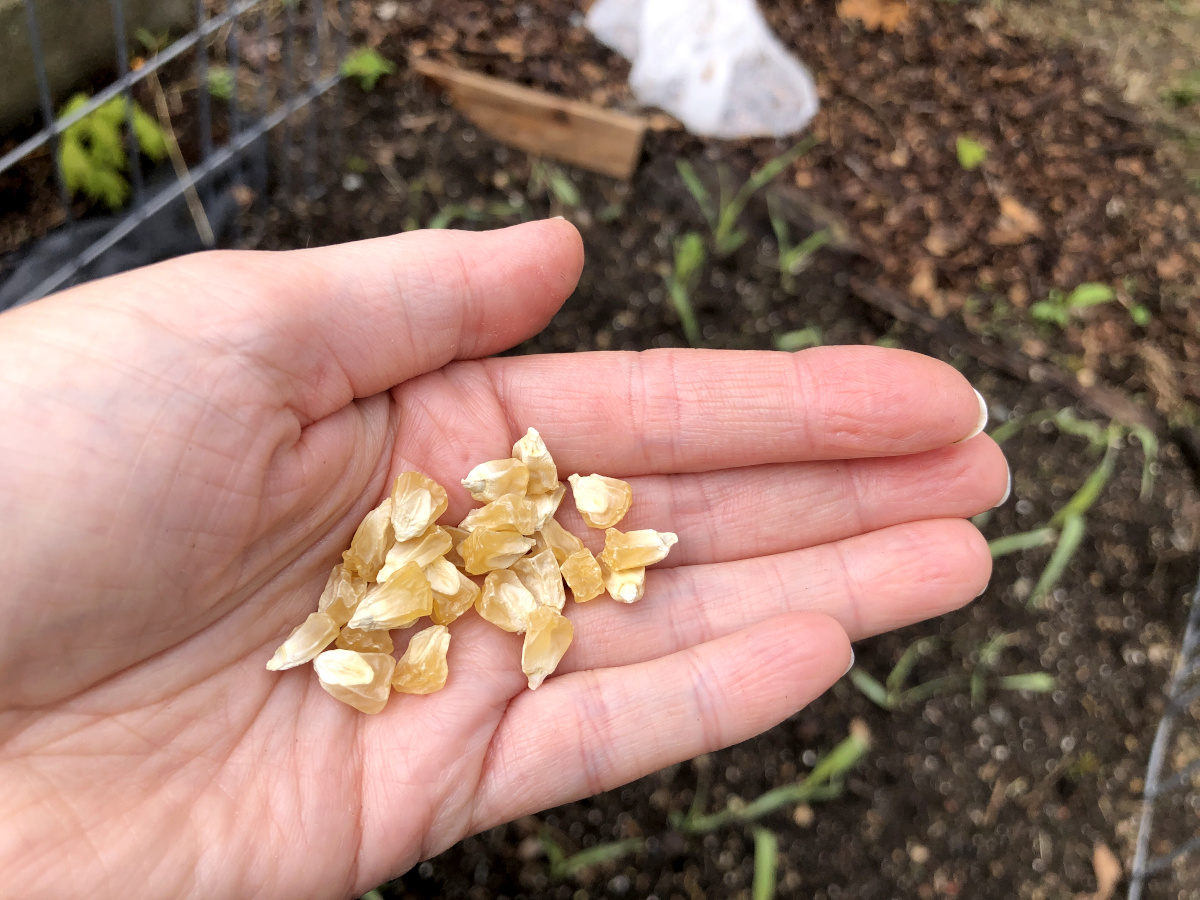
Corn seeds are quite large in size compared to other seeds, they are dry, very hard, shriveled, and large, so it is very beneficial for them to be soaked before planting.
As I said above, I like to soak my corn seeds because the space under my grow lights is limited and very precious. I like to have seeds sprout, grow, and seedlings established as soon as possible, so I can plant them outside as quickly and make the space under the grow lights available for something else again. I never have an empty space under my grow lights and always have some seeds going. This way, I can plant in succession, meaning as soon as I pull something out of my growing space, I am able to plant a new plant in that empty space. During the growing season, a growing space should be occupied all the time to increase harvest and yields.
It is recommended to soak up the seeds with a hard shell or large seeds that take time to sprout. In order to soften the seed shell, and in order for the large seeds to germinate faster, simply soak the seeds in water. Soak small seeds overnight, and larger seeds such as beans, corn, and peas for a day or two. Do not keep the seeds in water longer than 2 days, and always check the seeds daily. If the seeds are left in water for too long, they get mushy or start to ferment. When you see the shell softened up and the seeds have swollen, they are ready to be sowed in the soil.
How do you prepare the ground for planting corn?
Corn likes fertile loamy, well-draining soil full of organic matter. Loosen up the soil and add organic matter like compost or aged animal manure, then plant corn. If corn plants are not well fertilized, it will not produce much and the ears will be very small, sparse, and not that appealing. Ensure the corn plants grow in fertile soil and fertilize regularly.
Corn has thick shallow roots that spread out rather than growing deep in the ground. The plant will not reach deep down for nutrition or water, so it needs to be provided by the grower rather close to the surface than too deep in the ground.
Corn does not like to be crowded or grown in groups. Because the roots spread out rather horizontally underground, this plant likes to have its own space. I plant corn usually about 9 inches apart, but not closer. It is a crop that takes up a lot of space. Each plant yields for about 1-2 years only. In order to have a substantial crop of corn, one needs lots of space, which I do not have available in my garden. But I still find some space for it to grow as there is nothing that beats the taste and fragrance of freshly harvested and boiled corn on the cob!
It does not need any babysitting. Accept at sowing. Many rodents like to dig out the seeds and eat them. This is also the reason I like to start my corn crop indoors, to prevent the seeds from being eaten up.
Once the corn seedlings are planted outdoors, be prepared that some rodents might still eat the seeds underneath, or they simply chop off the plant across. I lose one or two plants every year before they get really well-established. But that’s ok, just plant more than you need to catch up with losses. Planting more than you need is always recommended to count losses.
TIP: If you want to harvest 5 broccoli, do not plant 5 broccoli seeds. Always plant more to count losses into account. Some seeds might not sprout, and some seeds might die after sprouting. Some seeds might get eaten. Some seedlings might get severed by weather, or rodents after being planted outside. Some seedlings might just die down. Close to harvest, some yields might get eaten by pests. Sometimes flowers do not get pollinated well and do not yield. Always plant more to count many, many losses.
I would be happy with 3 very well-producing tomato plants. But to ensure I have 3 well-producing tomato plants; I plant 6 or 7 of them to count losses in. If all plants make it, well, hurray to more harvest! If only 3 make it, well that’s what my goal was so hurray again! I cannot stress enough how crucial it is to sow and plant more than you need. As a rule of thumb, for my home garden, I always plant at least 50% more than I want to harvest at the end of the plant’s life cycle, or at the end of the growing season.
How long does corn take to grow?
Corn takes 70-100 days to grow from seed to harvest. Always check the seed packet for days to harvest as the days to harvest vary depending on the variety. For continuous harvest plant in succession, every two weeks apart.
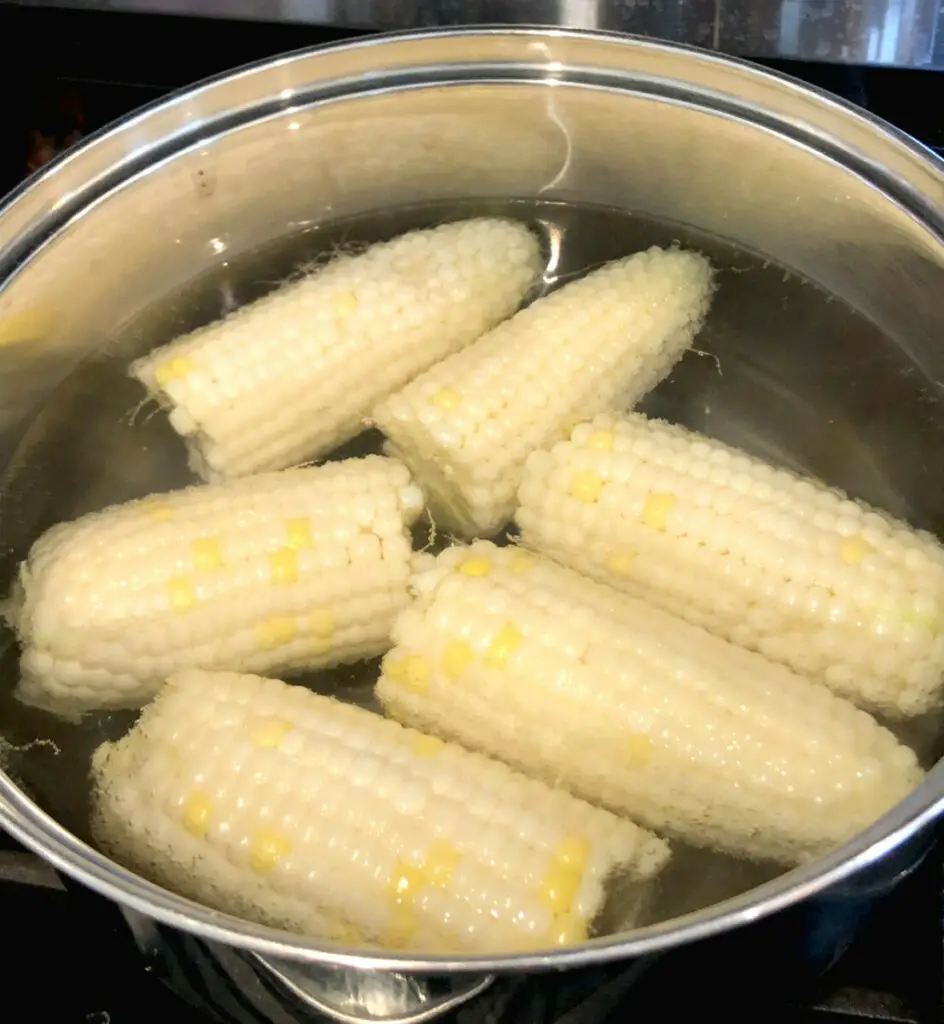
What not to do when growing corn?
- Never plant anything in very wet soil as the soil gets compacted and it will make it difficult for the roots to spread, the health and strength of the plant will get affected.
- Corn likes to be fertilized, so it fertilizes periodically.
- Do not plant corn seeds too deep. Aim to sow the corn seeds about 2 inches deep. Corn has shallow roots and if planted too deep, the sprout might not make it to the surface and die down before it reaches the soil surface because it spent all its energy reaching the surface.
- Do not plant corn seeds too shallow. Corn has shallow roots, if planted too shallow the roots will not be well established and the corn will not be strongly anchored in the ground and will get knocked down by winds and uprooted.
- Inspect the plants for pests and diseases
- Support the corn plants if needed. Corn plants are tall and often get knocked down by heavy rains or winds. If it falls over, straighten it by hand, support it if you can, and let it go.
How to keep the corn from falling over
I found many gardeners have problem with corn falling over and many find it very discouraging to deal with it. This is what I do to keep my corn plants from falling over: I like to simply tie a string around the whole circumference of the corn patch so the patch uses its own weight to support itself. And often I choose to stick in the ground a few tomato cages between the plants for extra support. As the plants fall over, the tomato cage is there to catch and hold them. As corn is planted in patches, I use the patch’s weight to support its weight. Try to tie one round of string around the patch about 2 feet from the ground up and the second round about 4 feet up from the ground, and stick a tomato cage between the plants every 5-6 feet apart and they will be good to go!
How do you get high yields from corn?
- Ensure the corn is planted when warm and the danger of the last frost is no more
- Ensure the soil is fertile and fertilize and water regularly
- Keep appropriate spacing when planting
- Sow corn in a sunny location
- Do not let weeds suffocate your corn plants
- Hand-pollinate your corn plants
- Always plant more than you want to harvest to count with losses. There will be losses for sure, plant more to accommodate them.
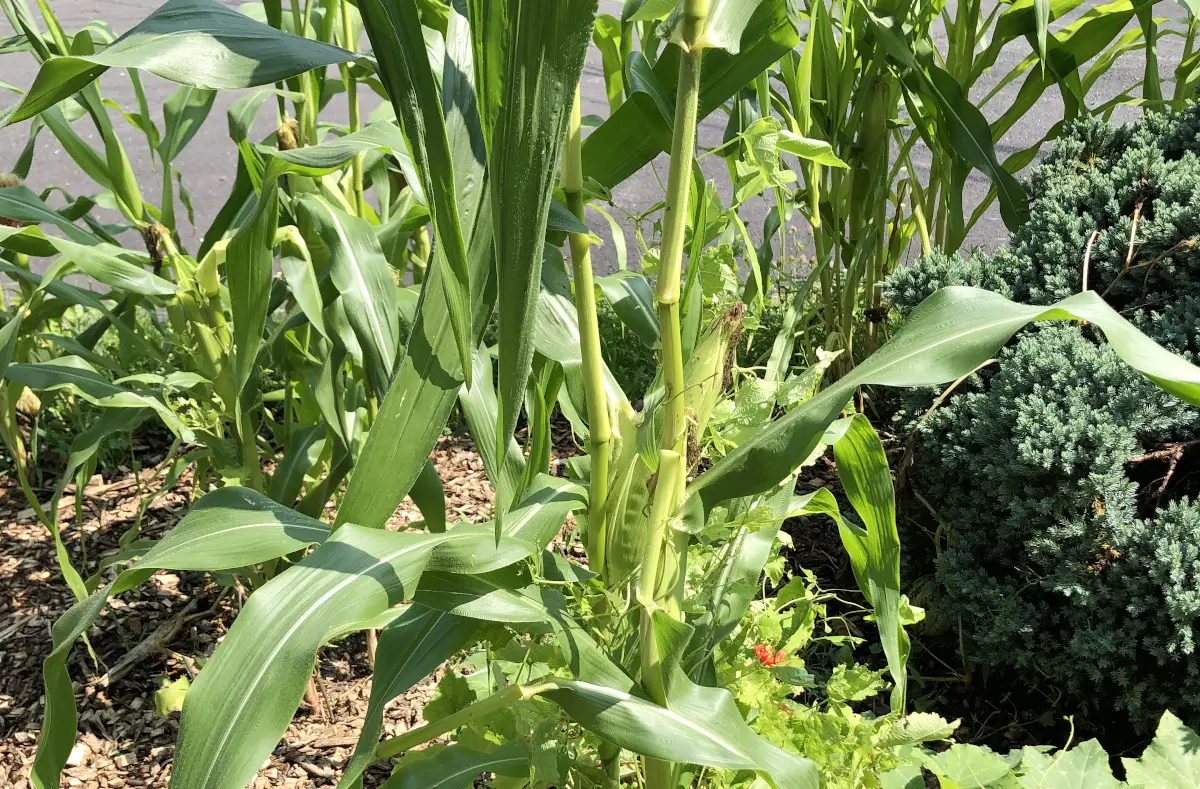
Why are my corn ears small or not edible?
Corn ears do not develop well or fully when they have not been well pollinated, or not well fertilized and watered. In order to get the full large ears of corn, the plant needs to be well watered, fertilized, and pollinated. Hand pollinate, especially if the corn patch in the home garden is very small in size.
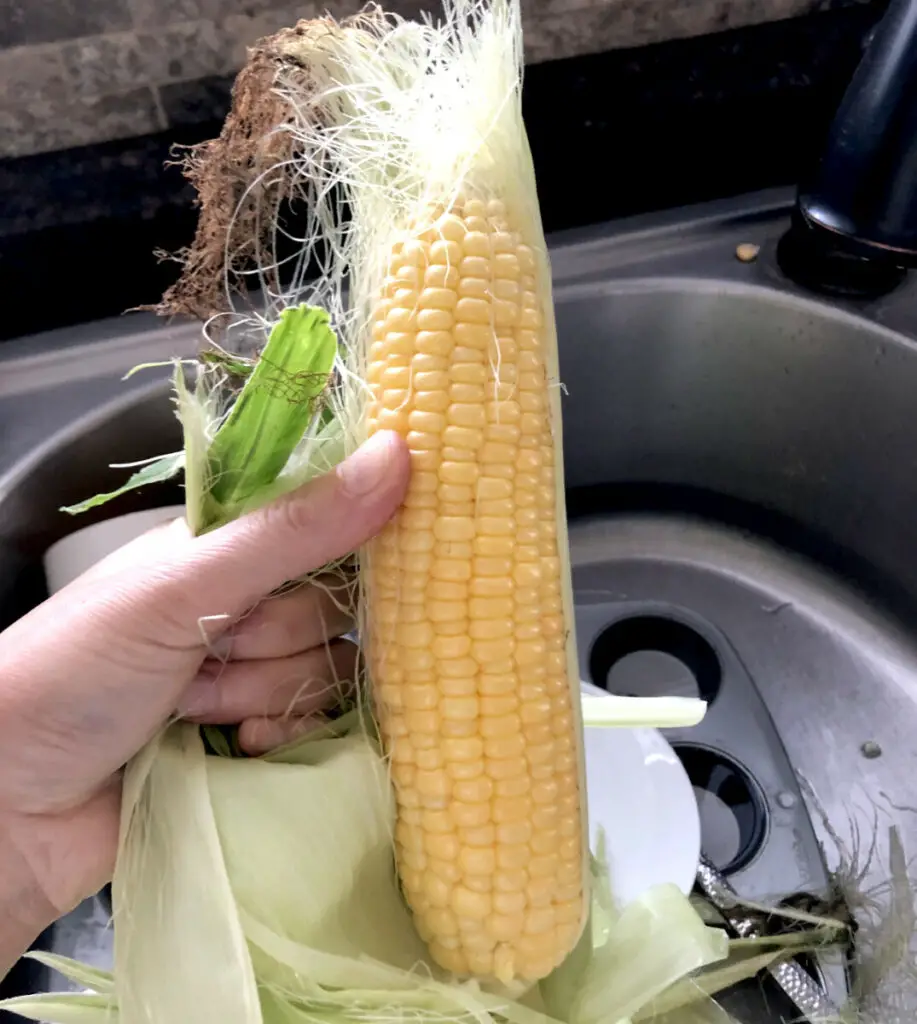
How to hand pollinate corn?
This is how to hand-pollinate corn. Take a paper plate and shake the male flower on top of the plant, and catch the yellow pollen that looks like yellow powder, and the small flower pieces with the paper plate. Then grab some pollen and flower pieces in your hand and sprinkle them on the silk of the female flower. Gather the pollen when it is sunny and not very windy so most of the pollen gets caught by you. Pollinate the female flowers when there is no rain in the coming for two or three days so the pollen sits on the silk and gets as deep in the female flower as possible. If there is a danger of rain and the corn is flowering, collect the pollen and store it in a dark dry place to use after the rain has passed. Rain washes off the pollen and female flowers might get very little of it after the rain, especially if the corn patch is very small in size. The larger the corn patch the more chance for good pollination. The smaller the patch the more help it needs to pollinate. It is not tedious to hand pollinate, pollinate once or twice a week only till male flowers run out of pollen, or till all female flowers with silk are well pollinated.
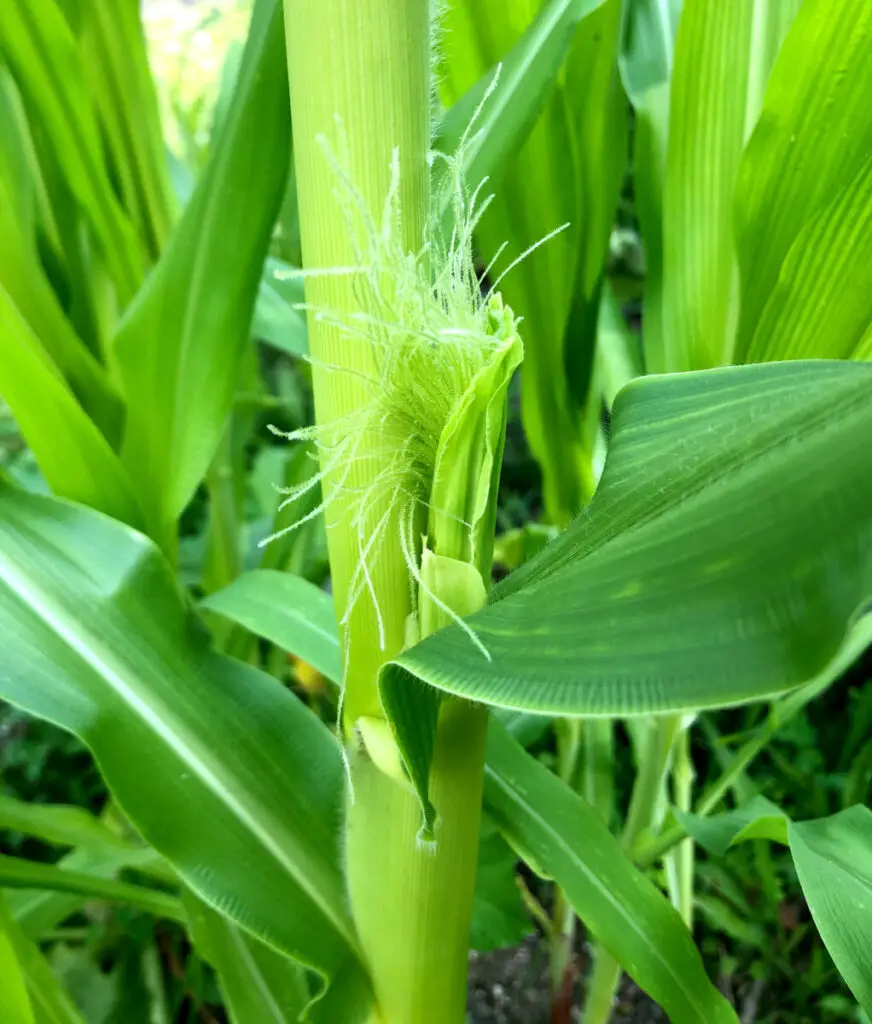
One corn plant yields only 1-2 ears of corn. I do not like to take any chances, so I hand-pollinate my corn. Corn pollinates by the wind. As the wind blows, it shakes the whole plant. The male flower is on the very top of the plant with all the pollen that the female flower needs in order to yield. As the wind shakes the plant and blows around the plant, the pollen is taken by the wind and falls down and around the plant to reach the female plant. The female plant is the one with silk. Pollen needs to reach silk in order for the fruit to form.
Get sweet corn seeds here, and get growing!
Do you grow corn in your home garden? If so, please share with us what variety is your favorite to grow and eat and why.
When and how to plant cucumbers
How to find out if the seeds are viable

